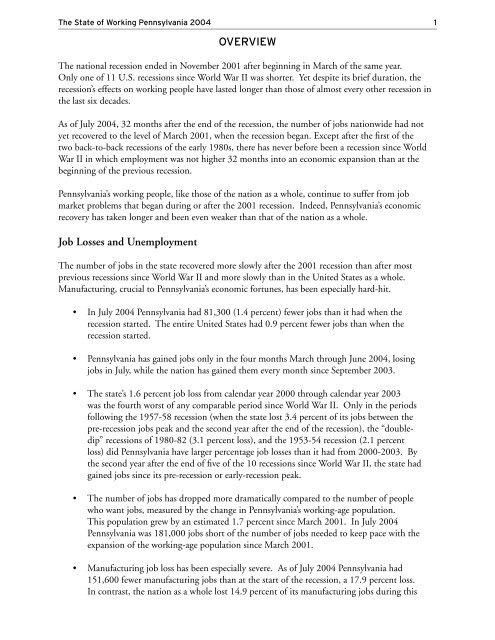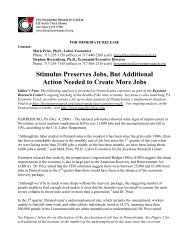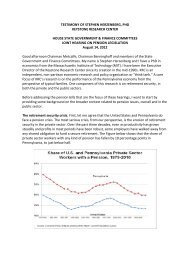The State of Working Pennsylvania 2004 - The Keystone Research ...
The State of Working Pennsylvania 2004 - The Keystone Research ...
The State of Working Pennsylvania 2004 - The Keystone Research ...
Create successful ePaper yourself
Turn your PDF publications into a flip-book with our unique Google optimized e-Paper software.
<strong>The</strong> <strong>State</strong> <strong>of</strong> <strong>Working</strong> <strong>Pennsylvania</strong> <strong>2004</strong> 1<br />
OVERVIEW<br />
<strong>The</strong> national recession ended in November 2001 after beginning in March <strong>of</strong> the same year.<br />
Only one <strong>of</strong> 11 U.S. recessions since World War II was shorter. Yet despite its brief duration, the<br />
recession’s effects on working people have lasted longer than those <strong>of</strong> almost every other recession in<br />
the last six decades.<br />
As <strong>of</strong> July <strong>2004</strong>, 32 months after the end <strong>of</strong> the recession, the number <strong>of</strong> jobs nationwide had not<br />
yet recovered to the level <strong>of</strong> March 2001, when the recession began. Except after the first <strong>of</strong> the<br />
two back-to-back recessions <strong>of</strong> the early 1980s, there has never before been a recession since World<br />
War II in which employment was not higher 32 months into an economic expansion than at the<br />
beginning <strong>of</strong> the previous recession.<br />
<strong>Pennsylvania</strong>’s working people, like those <strong>of</strong> the nation as a whole, continue to suffer from job<br />
market problems that began during or after the 2001 recession. Indeed, <strong>Pennsylvania</strong>’s economic<br />
recovery has taken longer and been even weaker than that <strong>of</strong> the nation as a whole.<br />
Job Losses and Unemployment<br />
<strong>The</strong> number <strong>of</strong> jobs in the state recovered more slowly after the 2001 recession than after most<br />
previous recessions since World War II and more slowly than in the United <strong>State</strong>s as a whole.<br />
Manufacturing, crucial to <strong>Pennsylvania</strong>’s economic fortunes, has been especially hard-hit.<br />
• In July <strong>2004</strong> <strong>Pennsylvania</strong> had 81,300 (1.4 percent) fewer jobs than it had when the<br />
recession started. <strong>The</strong> entire United <strong>State</strong>s had 0.9 percent fewer jobs than when the<br />
recession started.<br />
• <strong>Pennsylvania</strong> has gained jobs only in the four months March through June <strong>2004</strong>, losing<br />
jobs in July, while the nation has gained them every month since September 2003.<br />
• <strong>The</strong> state’s 1.6 percent job loss from calendar year 2000 through calendar year 2003<br />
was the fourth worst <strong>of</strong> any comparable period since World War II. Only in the periods<br />
following the 1957-58 recession (when the state lost 3.4 percent <strong>of</strong> its jobs between the<br />
pre-recession jobs peak and the second year after the end <strong>of</strong> the recession), the “doubledip”<br />
recessions <strong>of</strong> 1980-82 (3.1 percent loss), and the 1953-54 recession (2.1 percent<br />
loss) did <strong>Pennsylvania</strong> have larger percentage job losses than it had from 2000-2003. By<br />
the second year after the end <strong>of</strong> five <strong>of</strong> the 10 recessions since World War II, the state had<br />
gained jobs since its pre-recession or early-recession peak.<br />
• <strong>The</strong> number <strong>of</strong> jobs has dropped more dramatically compared to the number <strong>of</strong> people<br />
who want jobs, measured by the change in <strong>Pennsylvania</strong>’s working-age population.<br />
This population grew by an estimated 1.7 percent since March 2001. In July <strong>2004</strong><br />
<strong>Pennsylvania</strong> was 181,000 jobs short <strong>of</strong> the number <strong>of</strong> jobs needed to keep pace with the<br />
expansion <strong>of</strong> the working-age population since March 2001.<br />
• Manufacturing job loss has been especially severe. As <strong>of</strong> July <strong>2004</strong> <strong>Pennsylvania</strong> had<br />
151,600 fewer manufacturing jobs than at the start <strong>of</strong> the recession, a 17.9 percent loss.<br />
In contrast, the nation as a whole lost 14.9 percent <strong>of</strong> its manufacturing jobs during this







